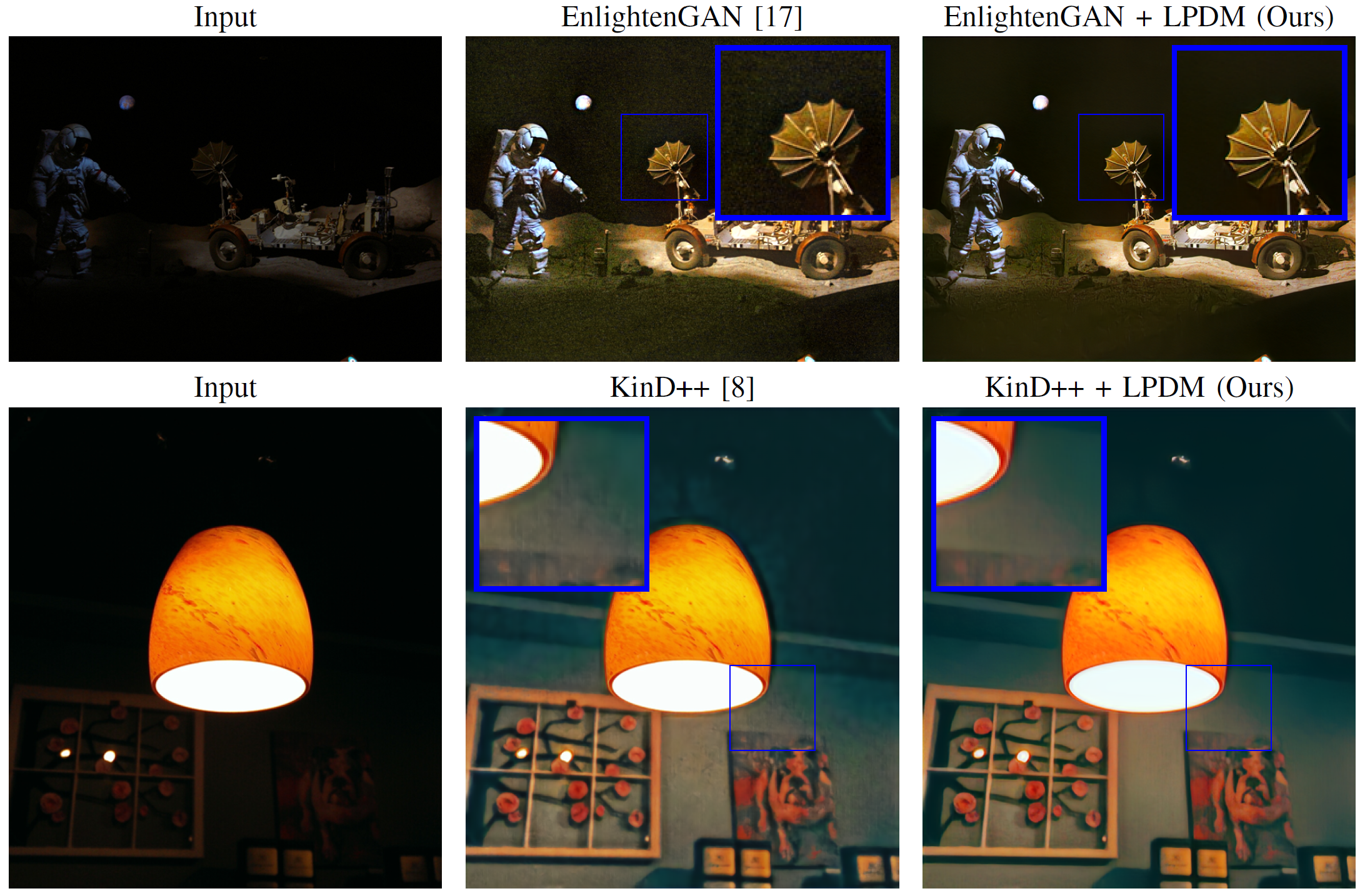Abstract: Low-light image enhancement (LLIE) techniques attempt to increase the visibility of images captured in low-light scenarios. However, as a result of enhancement, a variety of image degradations such as noise and color bias are revealed. Furthermore, each particular LLIE approach may introduce a different form of flaw within its enhanced results. To combat these image degradations, post-processing denoisers have widely been used, which often yield oversmoothed results lacking detail. We propose using a diffusion model as a post-processing approach, and we introduce Low-light Post-processing Diffusion Model (LPDM) in order to model the conditional distribution between under-exposed and normally-exposed images. We apply LPDM in a manner which avoids the computationally expensive generative reverse process of typical diffusion models, and post-process images in one pass through LPDM. Extensive experiments demonstrate that our approach outperforms competing post-processing denoisers by increasing the perceptual quality of enhanced low-light images on a variety of challenging low-light datasets. Source code is available at https://github.com/savvaki/LPDM.
The image results for all techniques and datasets are available for download here.
-
undarkendirectories contain$\hat{\boldsymbol{x}}_0^\eta$ for each low-light enhancement technique$\eta$ . In other words, these are the results before post-processing. -
denoiseddirectories contain the results of LPDM in thelpdm_lolsubdirectory, as well as the results for the ablation studies. For the LOL dataset, the results of NAFNet and BM3D are also provided. BM3D results are provided for different values of$\sigma$ . - The LPDM results have subdirectories in the format phi_s which indicate the
$\phi$ and$s$ parameters used.
Set up and activate the virtual conda environment:
conda env create -f environment.ymlconda activate lpdm
- Download the pre-trained model
.ckptfile and.yamlfile here and place them in thecheckpointsdirectory:───checkpoints ├───lpdm_lol.ckpt └───lpdm_lol.yaml - Modify the
sandphi(φ) parameters inconfigs/test/denoise.yamlas desired. - Place your low-light images (c) in the
test/darkdirectory - Place your enhanced images by any enhancer η in the
test/etadirectory. Make sure the images have the same names as the files intest/dark - Run the following commands:
cd scripts python denoise_config.py - Denoised results can be found in
test/denoised - Run the following command for info about optional extra settings:
python denoise_config.py --help. - By default, the device is set to CPU. To use GPU pass the argument
--device "cuda"
- Modify
configs/test/metrics.yamland specify the denoised image glob pathpred_pathand the ground truth glob pathtarget_path. To use non-reference metrics, removetarget_pathfrom the config. - Run the following commands:
cd scripts python calculate_metrics.py - Metrics will be saved in
test/results.csv. - For additional options run
python calculate_metrics.py --help
-
Download the LOL Dataset here. Unzip the dataset and place the contents in the
datasets/loldirectory:───datasets └───lol ├───eval15 │ ├───high │ └───low └───our485 ├───high └───low -
For the commands below, PyTorch lightning will create a
logsdirectory where checkpoints will be saved. -
For GPU training options pass the
--gpuargument according to PyTorch Lighting documentation. The examples below use one GPU. -
Train and log locally:
python main.py --base configs/train/lpdm_lol.yaml --gpu 0,
-
Train and log metrics with wandb:
- Set your wandb environment variables:
WANDB_API_KEY,WANDB_ENTITY,WANDB_PROJECT python main.py --base configs/train/lpdm_lol.yaml --logger_to_use wandb --gpu 0,
- Set your wandb environment variables:
-
An example command to resume a saved checkpoint in the directory
RUN_DIRECTORY_NAME_HEREusing wandb logging:python main.py --resume logs/RUN_DIRECTORY_NAME_HERE --logger_to_use wandb --gpu 0,
-
To reduce the size of the model, reduce the
model_channelsparameter inconfigs/train/lpdm_lol.yaml
@misc{panagiotou2023denoising,
title={Denoising Diffusion Post-Processing for Low-Light Image Enhancement},
author={Savvas Panagiotou and Anna S. Bosman},
year={2023},
eprint={2303.09627},
archivePrefix={arXiv},
primaryClass={eess.IV}
}
This repository is a derivative of the original Stable Diffusion repository.




